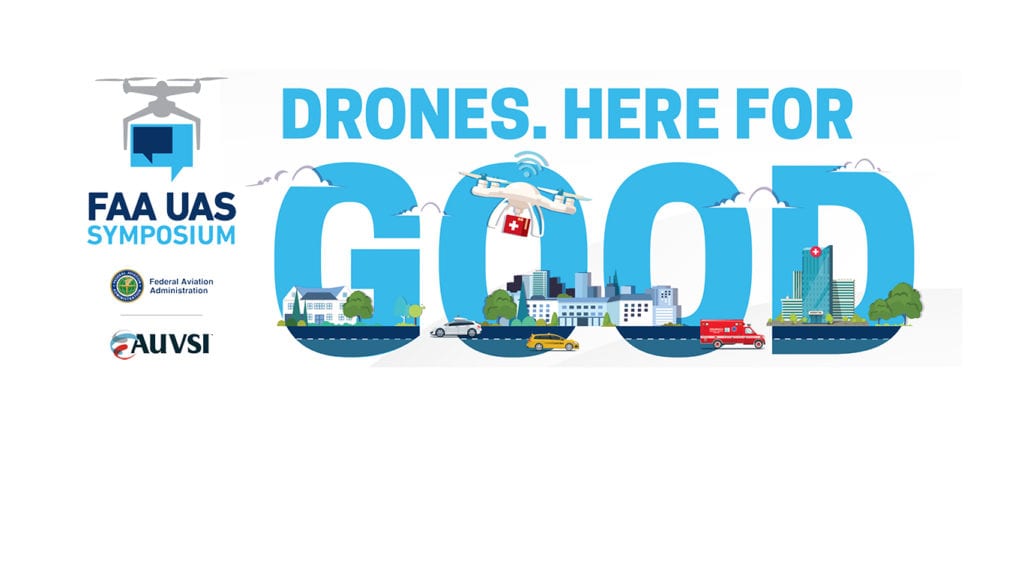
Under a new agreement, the FAA and Switzerland's FOCA will work together to test, evaluate and publish on various elements of UAS safety. (FAA/AUVSI)
The Federal Aviation Administration signed an agreement to work with the Swiss Federal Office of Civil Aviation (FOCA) on standards surrounding the safe use and integration of unmanned aircraft into civilian airspace, the agency announced during the 2020 FAA UAS Symposium remotely co-hosted with the Association for Unmanned Vehicle Systems International (AUVSI).
Under the declaration of intent (DOI), the two agencies intend to collaborate on projects related to UAS activities including unmanned traffic management (UTM) concept validation, airworthiness, control and communications, detect and avoid, human factors, low altitude safety, and training.
The agreement names FAA's UAS Integration Office and FOCA's Innovation and Digitalization Unit as the primary authorities for the agreement.
"UAS activities are now accepted worldwide as a vital sector of aviation," said Jay Merkle, executive director of the FAA's UAS Integration Office. "This U.S./Swiss agreement continues the move forward of the safe, efficient, and internationally harmonized integration of these vehicles into the world's airspace."
While the agreement doesn't hold the participating agencies to jointly developing UAS regulation, it is a commitment to joint development of best practices likely to influence future policy activities.
"International cooperation can only bring speed to the development of safe and sensible policy," commented Mike Pehel, chairman of InterDrone, referencing programs like the Joint Authorities for Rulemaking on UAS (JARUS) and Specific Operations Risk Assessment (SORA). "I'm excited to see the FAA partnering with Swiss FOCA, one of the great forward-thinking bodies on UAS Integration, and believe this can only bring greater attention and scale to the data the Swiss U-Space implementation is producing with its ‘authorize and assess' philosophy."
Discussions about unmanned aircraft integration and UTM development during the FAA's UAS Symposium underlined the importance of standards harmonization across borders. Failure to do so, government and industry participants noted, will reduce the ability for operational learnings to transfer, slow down the development of best practices and – in the long term – impact industry's ability to innovate and provide services in a cost-effective manner.
"From an operator's perspective, if there are significantly different means of operations, if there are different methods of compliance and kinds of tools, that complexity can affect the operator's ability to repeatably execute an operation," said Reinaldo Negron, head of UTM for Wing. "We see that as another key risk if we don't have some of the harmonization that's happening."
"Without these common standards, we'll have a patchwork of expectations and requirements that will make it very difficult for businesses globally to operate globally," said Michael Thacker, executive vice president of innovation and commercial business at Bell.
One challenge noted with regards to harmonization efforts is getting enough international engagement in global standards bodies such as ASTM, which has developed standards for drone remote identification, operational risk assessment and more. Limited engagement during the standards formation process can result in uncertain levels of buy-in once the standard is produced, noted FAA's Merkle.
In particular, the fundamentals of unmanned traffic management systems "really caught on globally thanks to NASA," Merkle said, but has morphed in some areas of the world and "we're having a hard time keeping everyone together … a challenge that will remain for a while as we see this mature."
The results of any collaborative FAA-FOCA testing and analysis connected to the newly-signed agreement is expected to be "jointly owned," according to the text of the agreement, with the participants to "mutually decide on the terms of first publication." A working agenda is expected to be established within 60 days.
